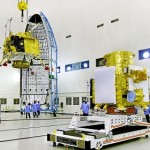The People’s Republic of China celebrates its National Space Day on 24 April every year. This year’s space day has come in the wake of remarkable global geo-economic friction and posturing.
As a riposte to the U.S.’ conception of a space coalition under its umbrella agreement known as the Artemis Accords, China and Russia have officially announced the building of the International Scientific Lunar Station (ISLS).
The ISLS, as per the announcement, will consist of robotic and crewed research facilities on the Moon’s surface and in its orbit.
In 2019, at the fag end of the Trump administration, the U.S. got many of its longstanding partners to sign the Artemis Accords. Canada, the United Kingdom, Luxembourg, Italy, Ukraine, United Arab Emirates, Japan, and Australia are party to this US-led agreement.
These signatories affirm a shared comprehension of space laws, particularly Article IX of the Outer Space Treaty, sharing resources, data, technical standards, and agreeing to assist each other in the rescue and return of astronauts in distress.
In short, this coalition will act as a unified astro-political bloc with common interests.
They will collectively build cis-lunar infrastructure, transportation, logistics, and telecommunications connectivity build-out between the Earth and the Moon.
As an obvious counter to this Western bloc, the ROSCOSMOS’ and China National Space Agency’s announcement states:
“Taking into account the experience of the Russian Federation and the People’s Republic of China in the field of space science, the creation and use of space systems and space technologies, recognizing the mutual interest in the creation of the International Scientific Lunar Station, guided by the legislation of their states, generally recognized principles and norms of international law, international treaties, of which their states are participants, and to cooperate on the principles of equality, openness and honesty, hereby jointly publish a statement on cooperation in the field of creating the ISLS.”
Both the astro-political blocs have a different worldview.
Their perception of international law, rules, and global order differ. It is this polarity that has become the cause of an intense and titanic Second Space Race.
There is perhaps a possibility that the Russo-Chinese cooperation may expand to many Shanghai Cooperation Organization members as well as China’s close partners in the Belt and Road Initiative.
India is in no position to call itself non-aligned and be a bystander ready to be blown by the gusts of astro-political winds. New Delhi did so during the First Space Race, and our space programme was unable to help the Indian economy as it should have.
A reticent stance also made India vulnerable to sanctions, embargoes, and conspiracies. The excruciating cryogenic engine machination has caused India dearly.
Let’s be honest here. India undertook space exploration after great socialistic apprehensions. The apprehension continues to this day, as India shies away from venturing out frequently.
A mission a decade to the Moon or Mars is not going to help India at all. The gap between the launch of the first two Chandrayaan spacecraft has been eleven long years. It has been eight years since ISRO launched Mars Orbiter Mission, and the next Mars mission is not anywhere on the horizon.
Neither the Artemis Accord alliance nor the Moscow-Beijing combine are espousing such pusillanimous exercise of scientific exploration.
Indeed, science is a significant undercurrent of what they want to attain between the Earth and the Moon. Their goal is to attain tangible economic and meta-strategic stakes in the emerging space economy.
The Moon Market Analysis, a report from a space market research company, Northern Sky Research, predicts nearly US$42 billion in the next ten years entirely from infrastructure build-out in lunar orbit and surface.
The two blocs aim for more significant stakes in the space economy that will grow from nearly 450 billion dollars at present to 3 trillion dollars by 2040.
New Delhi must comprehend these fast-paced actions. Until recently, Moon and Martian exploration (which constitutes the near-Earth space due to its proximity to the Earth) was entirely geared towards scientific prospection, surveillance and reconnaissance. The colossal volumes of data generated from the tens of missions that went to these two bodies have set the foundation of what follows – economic extra-terrestrial activities.
To initiate these economic activities, the Chinese experimented how to communicate from the far side of the Moon. The Americans have now undertaken the first-ever helicopter flights on Mars and recently demonstrated in-situ oxygen generation on the Martian surface.
The two, Chandrayaan and Mars Orbiter, have been technically competent. Our scientists and technologists demonstrated what we had to. The concern, however, is the absence of a national space exploration strategy.
To add to that, our space exploration missions and plans are not economically-minded. With most nations nucleating around the two astro-political blocs, India must realise that its exploration plans cannot be self-satisfied anymore.
India needs to immediately comprehend its stance and strategy in the Second Space Race, whose first bugle was blown after the signing of Artemis Accords.
The announcement of the Russo-Chinese ISLS is the second bugle and a forewarning that leaving space exploration to a few science aficionados can be dangerous. India needs a national space exploration strategy with tangible economic and meta-strategic goals in sight, fitting of a superpower. Do it now.
This article was first published in Swarajya.
Chaitanya Giri is Fellow, Space and Ocean Studies Programme, Gateway House.


